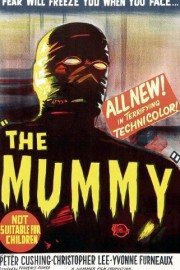The Mummy (’59)
The horror films put out by the Britain’s Hammer studio starting in the late ’50s feel like a natural progression from the Universal films that helped define the genre starting in the ’30s. Both studios brought a particular aesthetic to the genre that hearkened to the Victorian era during which many of the stories originated in print. Production design was a big part of the allure of these films, as well as the actors in them. Each studio set itself up like a factory, employing the same filmmakers and actors over and over. Unlike a shared universe like Marvel’s current mega-franchise, however, these studios were putting together isolated films (or franchises), with only the people making the films being consistent. This resulted in quality that varied greatly from classic (“Bride of Frankenstein,” “Horror of Dracula”) to not so much (any number of the Universal sequels), but in a steady stream of terror for audiences to sink their teeth into. Regardless of quality, though, both brands have garnered many fans over the decades who liked what Universal or Hammer were putting out.
After beginning to dig into Hammer’s horror slate for the first time about 12 years ago, I haven’t spent too much time in recent years doing so, but not out of appreciation. The fact of the matter, though, is that Hammer’s type of horror is probably my favorite I’ve experienced since beginning to delve into the early years of the genre. The secret to their success, with me, lies in the Technicolor images they put on the screen, the beautifully evocative art direction that makes each film come to life, and of course, the actors they used to tell their stories. By the time I watched “Horror of Dracula” for the first time, I had already seen stars Peter Cushing and Christopher Lee in their respective roles in “Star Wars” and “Lord of the Rings,” so I knew who they were. However, watching their work in Hammer’s films made me realize why they were so important to film history. Though Lee was more in the villain role, not saying much, he did a great job conveying the terror necessary to embody his roles in the tradition of Karloff and Legosi in the Universal films. As his opposite, Cushing used his sinuous voice to bring an authority and tenacity to his roles that helped bring an intelligence and urgency to the films. Friends in real life, they made great adversaries on screen, and it’s exciting to watch even now.
In “The Mummy,” Hammer’s 1959 variation on the old Egyptian legends, Cushing takes center stage as John Banning, the son of a famed British archaeologist who is just as driven as his father is to unearth the tomb of the Egyptian princess Ananka on a dig. They find what they are looking for, and much more than they bargained for, when they find the tomb, and Banning’s father has an episode that leaves him in shock, and he spends the rest of his life in an institution. For three years after the dig, the elder Banning makes reference to a mummy that had come to life and attacked him. During a lucid moment, he conveys this story to his son, but John dismisses it, although after his father is violently killed in custody by an outsider, he starts to consider that maybe his father is right. When his uncle, who was also on the expedition, is killed in front of him by the mummy (played by Lee), he is certain of it, although trying to convince the police inspector of it will be another matter.
The writer and director on “The Mummy” are Jimmy Sangster and Terence Fisher, respectively, who also collaborated on Hammer productions such as “Horror of Dracula” and “The Revenge of Frankenstein,” two of my other favorite Hammer films. The story they tell is a fascinating one, with a twist that happens near the end of Isobel (Yvonne Furneaux), John’s wife, being the spitting image of Ananka. (Of course, it’s easy to do by having Furneaux play both roles.) Doing that offers John a chance at survival when Isobel tells the mummy (who was in love with Ananka, and died being ordered to protect her in the afterlife) to stop harming John. An Egyptian worshiper (George Pastell) of the God Carnac, though, is the real reason the mummy is seeking revenge- he is distressed by these foreigners who are desecrating the ancient burial ground of this princess, and the history of their land for profit. He has a point, but it’s the terror that is ultimately what matters to Sangster and Fisher, and as they showed in their collaborations for Hammer, they were masters of horror storytelling laced with suspense. This is one of their best, and a great look at the sort of filmmaking that used to be the rule in horror cinema before such intelligence would become the rare in the genre.










